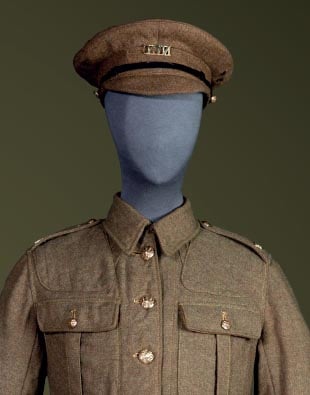NON-COMBATANT CORPS
In 1916, two years into the First World War, conscription was introduced. This meant that all single (and, later, married men) aged 18 to 41 had to join the army. However, not everyone agreed with the war. Some men refused to fight as it went against their conscience. These men were known as ‘conscientious objectors’. Many conscientious objectors were ordered to join a military unit called the Non-Combatant Corps (NCC).
Richmond Castle became a base for the northern companies of the NCC. Here, men could support the war without fighting or using weapons. Their duties were mainly labour, such as building, cleaning or loading supplies.
THE RICHMOND SIXTEEN
As punishment, those men who refused to be involved in the war at all could be imprisoned in the cold and damp cell block at the castle. While there, some drew and wrote on the cell walls. The graffiti they left behind range from portraits of loved ones to political and religious statements.
Sixteen conscientious objectors from Richmond Castle faced the ultimate test of their beliefs when, in May 1916, they were sent to France. Once there, they were considered to be on active service and as a result could be shot for disobeying orders.
In France, the Richmond Sixteen refused to move supplies, were put on trial and found guilty. Each was ‘sentenced to suffer death by being shot’, which, after a short pause, was changed to 10 years’ hard labour.
INSIDE THE CELLS
The walls of the cells at Richmond are covered with hundreds of pencil drawings and inscriptions, which give a unique insight into the conscientious objector movement. The graffiti includes political slogans, religious hymns, portraits of loved ones and even a few examples of dark humour.
Take a 360° tour of the cells to see them for yourself with this interactive video!
THE INSIDE STORY
A new permanent exhibition at Richmond Castle tells the story of its people, history and now living heritage, from the 11th century Norman conquest to its occupation by the northern Non-Combatant Corps during the First World War.
The new exhibition has a number of new objects on display as well as an interactive area for children, telling the stories of some of the castle’s most famous and less well known characters. Click on the objects featured in our gallery below to discover their stories.
PLAN YOUR VISIT
Originally built to subdue the unruly North of England, Richmond Castle is one of the greatest Norman fortresses in Britain. During a visit you can learn all about the castle’s past, including the conscientious objectors and the Non-Combatant Corps, in the new interactive exhibition before taking a peaceful stroll round the secluded Cockpit Garden and soaking up the breathtaking views of the Yorkshire Dales.
If you are in the area, it is possible to combine a visit to Richmond Castle with a day out at nearby Barnard Castle or Middleham Castle, the favourite childhood home of Richard III.
Find out moreExplore the English Heritage Collection
-

Eight Interesting objects
Find out about eight of the most fascinating objects in the English Heritage collection.
-

Longthorpe Tower
Find out how English Heritage is working to preserve the remarkable wall paintings at Longthorpe Tower.
-

Unlikely works of art
English Heritage sites are home to some incredible works of art. Discover where you can find the most surprising of these and where they came from.







